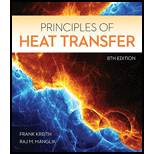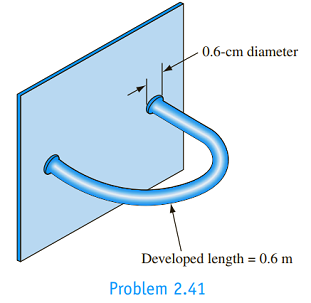
Principles of Heat Transfer (Activate Learning with these NEW titles from Engineering!)
8th Edition
ISBN: 9781305387102
Author: Kreith, Frank; Manglik, Raj M.
Publisher: Cengage Learning
expand_more
expand_more
format_list_bulleted
Textbook Question
Chapter 2, Problem 2.41P
Both ends of a 0.6-cm copper U-shaped rod are rigidly affixed to a vertical wall as shown in the accompanying sketch. The temperature of the wall is maintained at

Expert Solution & Answer
Trending nowThis is a popular solution!

Students have asked these similar questions
4. An impeller rotating at 1150 rpm has the following data: b, = 1 ¼ in., b2 = ¾ in., d, = 7 in., d2 =
15 in., B1 = 18", B2 = 20°, cross-sectional area A = Db if vane thickness is neglected. Assuming radial inlet flow, determine the theoretical
capacity in gpm
head in ft
horsepower
5. If the impeller in Problem (4) develops an actual head of 82 ft and delivers 850 gpm at the point of maximum efficiency and requires 22 BHP. Determine
overall pump efficiency
virtual velocities V2 and W2
(30 pts) Problem 1
A thin uniform rod of mass m and length 2r rests in a smooth hemispherical bowl of radius r. A
moment M
mgr
4
is applied to the rod. Assume that the bowl is fixed and its rim is in the
horizontal plane.
HINT: It will help you to find the length l of that portion of the rod that remains outside the
bowl.
M
2r
a) How many degrees of freedom does this system have?
b) Write an equation for the virtual work in terms of the angle 0 and the motion of the
center of mass (TF)
c) Derive an equation for the variation in the position of the center of mass (i.e., Sŕƒ)
a. HINT: Use the center of the bowl as the coordinate system origin for the problem.
d) In the case of no applied moment (i.e., M 0), derive an equation that can be used to
solve for the equilibrium angle of the rod. DO NOT solve the equation
e) In the case of an applied moment (i.e., M
=
mgr
= -) derive an equation that can be used to
4
solve for the equilibrium angle of the rod. DO NOT solve the equation.
f) Can…
Please show all work step by step
Chapter 2 Solutions
Principles of Heat Transfer (Activate Learning with these NEW titles from Engineering!)
Ch. 2 - A plane wall, 7.5 cm thick, generates heat...Ch. 2 -
2.2 A small dam, which is idealized by a large...Ch. 2 - 2.3 The shield of a nuclear reactor is idealized...Ch. 2 - A plane wall 15 cm thick has a thermal...Ch. 2 - 2.5 Derive an expression for the temperature...Ch. 2 - A plane wall of thickness 2L has internal heat...Ch. 2 - 2.7 A very thin silicon chip is bonded to a 6-mm...Ch. 2 - 2.9 In a large chemical factory, hot gases at 2273...Ch. 2 - 2.14 Calculate the rate of heat loss per foot and...Ch. 2 - 2.15 Suppose that a pipe carrying a hot fluid with...
Ch. 2 - Prob. 2.16PCh. 2 - Estimate the rate of heat loss per unit length...Ch. 2 - The rate of heat flow per unit length q/L through...Ch. 2 - A 2.5-cm-OD, 2-cm-ID copper pipe carries liquid...Ch. 2 - A cylindrical liquid oxygen (LOX) tank has a...Ch. 2 - Show that the rate of heat conduction per unit...Ch. 2 - Derive an expression for the temperature...Ch. 2 - Heat is generated uniformly in the fuel rod of a...Ch. 2 - 2.29 In a cylindrical fuel rod of a nuclear...Ch. 2 - 2.30 An electrical heater capable of generating...Ch. 2 - A hollow sphere with inner and outer radii of R1...Ch. 2 - 2.34 Show that the temperature distribution in a...Ch. 2 -
2.38 The addition of aluminum fins has been...Ch. 2 - The tip of a soldering iron consists of a 0.6-cm-...Ch. 2 - One end of a 0.3-m-long steel rod is connected to...Ch. 2 - Both ends of a 0.6-cm copper U-shaped rod are...Ch. 2 - 2.42 A circumferential fin of rectangular cross...Ch. 2 - 2.43 A turbine blade 6.3 cm long, with...Ch. 2 - 2.44 To determine the thermal conductivity of a...Ch. 2 - 2.45 Heat is transferred from water to air through...Ch. 2 - 2.46 The wall of a liquid-to-gas heat exchanger...Ch. 2 - Prob. 2.47PCh. 2 - The handle of a ladle used for pouring molten lead...Ch. 2 - 2.50 Compare the rate of heat flow from the bottom...Ch. 2 - 2.51 Determine by means of a flux plot the...Ch. 2 - Prob. 2.52PCh. 2 - Determine the rate of heat transfer per meter...Ch. 2 - Prob. 2.54PCh. 2 - 2.55 A long, 1-cm-diameter electric copper cable...Ch. 2 - Prob. 2.56PCh. 2 - Prob. 2.57PCh. 2 - Prob. 2.58P
Knowledge Booster
Learn more about
Need a deep-dive on the concept behind this application? Look no further. Learn more about this topic, mechanical-engineering and related others by exploring similar questions and additional content below.Similar questions
- Copyright 2013 Pearson Education, publishing as Prentice Hall 2. Determine the force that the jaws J of the metal cutters exert on the smooth cable C if 100-N forces are applied to the handles. The jaws are pinned at E and A, and D and B. There is also a pin at F. E 400 mm 15° D B 30 mm² 80 mm/ 20 mm 15° $15° 20 mm 400 mm 15° 100 N 100 N 15°arrow_forwardDraw for it make a match which directionarrow_forwardQ.1) Block A is connected to block B by a pulley system as shown. The weights of blocks A and B are 100 lbs and 70 lbs, respectively. Assume negligible friction between the rope and all pulleys as well as between block B and the incline and neglect the mass of all pulleys and cables. Determine the angle 0 required to keep the system in equilibrium. (At least two FBDs must be drawn for full credit) B Ꮎ 000arrow_forward
- pls solvearrow_forward+1. 0,63 fin r= 0.051 P The stepped rod in sketch is subjected to a tensile force that varies between 4000 and 7000 lb. The rod has a machined surface finish everywhere except the shoulder area, where a grinding operation has been performed to improve the fatigue resistance of the rod. Using a 99% probability of survival, determine the safety factor for infinite life if the rod is made of AISI 1080 steel, quenched and tempered at 800°c Use the Goodman line. Does the part fail at the fillet? Explainarrow_forwardSolve this problem and show all of the workarrow_forward
- I need drawing solution,draw each one by one no Aiarrow_forwardQu. 17 Compute linear density values for [100] for silver (Ag). Express your answer in nm''. . Round off the answer to three significant figures. Qu. 18 Compute linear density value for [111] direction for silver (Ag). Express your answer in nm'. Round off the answer to three significant figures. Qu. 19 Compute planar density value for (100) plane for chromium (Cr). Express your answer in nm?. Round off the answer to two significant figures. Qu. 20 Compute planar density value for (110) plane for chromium (Cr). Express your answer in nm ≥ to four significant figures. show all work please in material engineeringarrow_forward3-142arrow_forward
arrow_back_ios
SEE MORE QUESTIONS
arrow_forward_ios
Recommended textbooks for you
 Principles of Heat Transfer (Activate Learning wi...Mechanical EngineeringISBN:9781305387102Author:Kreith, Frank; Manglik, Raj M.Publisher:Cengage Learning
Principles of Heat Transfer (Activate Learning wi...Mechanical EngineeringISBN:9781305387102Author:Kreith, Frank; Manglik, Raj M.Publisher:Cengage Learning

Principles of Heat Transfer (Activate Learning wi...
Mechanical Engineering
ISBN:9781305387102
Author:Kreith, Frank; Manglik, Raj M.
Publisher:Cengage Learning
Heat Transfer – Conduction, Convection and Radiation; Author: NG Science;https://www.youtube.com/watch?v=Me60Ti0E_rY;License: Standard youtube license